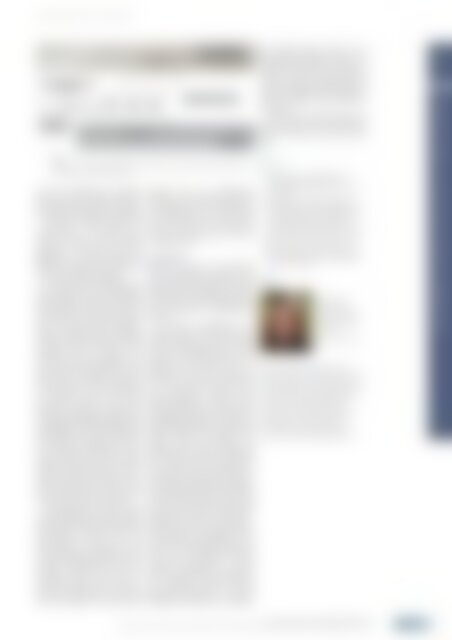atw - International Journal for Nuclear Power | 06.2021
Ever since its first issue in 1956, the atw – International Journal for Nuclear Power has been a publisher of specialist articles, background reports, interviews and news about developments and trends from all important sectors of nuclear energy, nuclear technology and the energy industry. Internationally current and competent, the professional journal atw is a valuable source of information. www.nucmag.com
Ever since its first issue in 1956, the atw – International Journal for Nuclear Power has been a publisher of specialist articles, background reports, interviews and news about developments and trends from all important sectors of nuclear energy, nuclear technology and the energy industry. Internationally current and competent, the professional journal atw is a valuable source of information.
www.nucmag.com
- No tags were found...
Create successful ePaper yourself
Turn your PDF publications into a flip-book with our unique Google optimized e-Paper software.
<strong>atw</strong> Vol. 66 (2021) | Issue 6 ı November<br />
| Fig. 6.<br />
Schematic of an inner and outer tailskin seal in partial-face excavation machine with description of the<br />
steering gap and annular gap [own figure].<br />
this is the classification of radiation<br />
protection areas according to §52 of<br />
the Radiation Protection Ordinance<br />
(German: Strahlenschutzverordnung<br />
= StrlSchV), which defines the<br />
annular gap as a ‚exclusion area‘,<br />
while the interior of the machine<br />
represents a ‚controlled area‘ (see<br />
Figure 6). For the outer tailskin seal<br />
the focus is on high wear resistance to<br />
obstacles outside the machine.<br />
As a result of the investigations, an<br />
inner tailskin seal was first designed<br />
which combines various conventional<br />
design elements. The basis <strong>for</strong> this is a<br />
wire brush seal with external spring<br />
plates and three sealing chambers,<br />
which is modified with a lubricant<br />
compression line and enlarged sealing<br />
chambers. With the help of the<br />
pressurised tail seal compound, this<br />
can meet the high demands on the<br />
barrier effect. In addition, the spring<br />
plates at the rear of the annular gap,<br />
in combination with the lubricant<br />
used, make it easier to start up the<br />
machine, as brushes in contact with<br />
the liquid backfilling (grout inside the<br />
annular gap) would stick together and<br />
be damaged over time. The lubricant<br />
itself also protects against the aggressive<br />
chemical environment in the<br />
adjacent annular gap. The enlarged<br />
sealing chambers increase the protection<br />
of the sealing system with a<br />
kind of spring effect – both in case of<br />
post-fractures from the rock mass and<br />
in case of occurring convergences.<br />
Subsequently, the outer tailskin<br />
seal was designed from three rows of<br />
spring plates, which are also modified<br />
with lubricant injection lines. The<br />
arrangement of three seal rows<br />
ensures sufficient redundancy, which<br />
is why the lubricant supply was also<br />
designed redundantly, so that the<br />
outermost seal row always has an<br />
associated supply line. In order to<br />
prevent the spring plates from being<br />
torn off by obstacles – such as barrel<br />
bundles from the emplacement<br />
chambers or rock fragments from the<br />
surrounding salt rock – their bearing<br />
was embedded in the shield casing<br />
and thus protected. The number of<br />
seals in a row also ensures a certain<br />
redundancy here.<br />
Conclusion<br />
Within the scope of the investigations,<br />
comprehensive findings were<br />
obtained <strong>for</strong> the problems occurring<br />
during shield tunnelling in the Asse II<br />
mine. So far, not all components have<br />
been investigated in a differentiated<br />
manner.<br />
In further investigations, <strong>for</strong><br />
example, aspects such as the interactions<br />
between the shield machine<br />
and the surrounding salt rock or the<br />
synergies and disadvantages of the<br />
parallel tunnel routes could be<br />
determined. It has been shown that<br />
the various situations of the partialface<br />
excavation machine with<br />
changing framings – such as salt rock,<br />
already hardened sorel concrete from<br />
preceding machines or contents of the<br />
emplacement chambers – represent a<br />
special challenge. Especially when<br />
feeding from cavity filling, the<br />
stability of the lateral walls along the<br />
travel distances plays an important<br />
role. Against this background, <strong>for</strong><br />
example, the sequence of the partialface<br />
excavation machines would have<br />
to be adjusted so that the first machine<br />
starts in the direction of travel on the<br />
left in order to be able to support itself<br />
against the salt rock in the south –<br />
especially in the area of the emplacement<br />
chambers (see Figure 2). The<br />
grouting (of the annular gap) in the<br />
area of the emplacement chambers<br />
could also be considered in more<br />
in-depth investigations. A further<br />
aspect would be the compatibility of<br />
the tunnelling concept with the<br />
emergency planning <strong>for</strong> a possible<br />
flooding of the Asse mine. At present,<br />
the reduced barrier effect of the<br />
drilled-through pillars between the<br />
emplacement chambers as well as the<br />
volume of the five shield machines<br />
and their underground infrastructure<br />
represent significant disadvantages of<br />
shield tunnelling with partial-face<br />
excavation.<br />
The retrieval of radioactive waste<br />
from the Asse II mine is scheduled to<br />
begin in 2033, in this sense: Glück<br />
auf!<br />
References<br />
[1] Plan zur Rückholung der radioaktiven Abfälle aus der<br />
Schachtanlage Asse II – Rückholplan, Verfasser:<br />
Bundesgesellschaft für Endlagerung mbH Peine/Remlingen,<br />
Stand: 19.02.2020<br />
[2] Machbarkeitsstudie für die Methode „Schildvortrieb mit<br />
Teilflächenabbau“ – Studie zur Eignungsfähigkeit und zum<br />
Entwicklungsbedarf von Gerätschaften/ Werkzeugen für den<br />
Einsatz in der Schachtanlage Asse II, Herrenknecht AG im<br />
Auftrag des Karlsruher Instituts für Technologie (KIT),<br />
Technologie und Management des Rückbaus kerntechnischer<br />
Anlagen (TMRK), Schwanau, Karlsruhe; Stand: 13.05.2015<br />
[3] Maidl, B., Herrenknecht, M., Maidl, U., Wehrmeyer, G. 2011.<br />
Maschineller Tunnelbau im Schildvortrieb. Ernst & Sohn<br />
[4] Schachtanlage Asse II: Nachweis der Langzeitbeständigkeit<br />
für den Sorelbaustoff der Rezeptur A1; ERCOSPLAN, TU BAF<br />
( IFAC), IFG; Stand: 10.08.2018<br />
Author<br />
Birte Froebus<br />
Research Assistant at<br />
Karlsruhe Institute of<br />
Technology, Karlsruhe,<br />
Germany<br />
birte.froebus@kit.edu<br />
Birte Froebus studied civil engineering at the<br />
Karlsruhe Institute of Technology (KIT), specialising in<br />
geotechnical engineering. In her master thesis, she<br />
took the opportunity to combine mechanised tunnel<br />
construction with the retrieval of radioactive waste,<br />
<strong>for</strong> which she was awarded the WiN-Germany<br />
Prize 2020/21. She then started working as a<br />
research assistant at the Institute <strong>for</strong> Technology<br />
and Management in Construction (TMB) in<br />
the ’ Deconstruction and Decommissioning of<br />
Conventional and <strong>Nuclear</strong> Buildings‘ department.<br />
DECOMMISSIONING AND WASTE MANAGEMENT 21<br />
Decommissioning and Waste Management<br />
Investigations of the Tailskin Seal During the Retrieval Concept ‘Shield Tunnelling with Partial-face Excavation’ in the Asse II Mine ı Birte Froebus
















